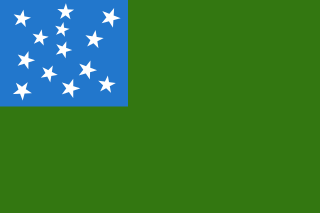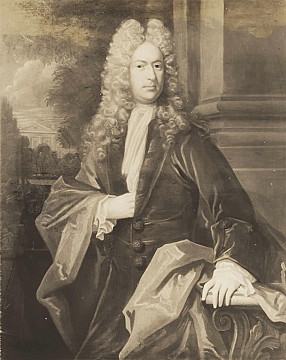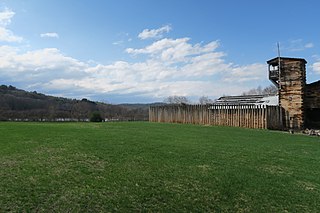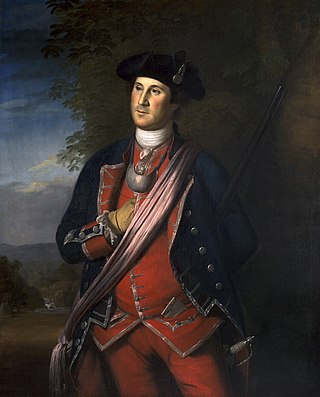Related Research Articles

The Green Mountain Boys were a militia organization established in 1770 in the territory between the British provinces of New York and New Hampshire, known as the New Hampshire Grants and later in 1777 as the Vermont Republic. Headed by Ethan Allen and members of his extended family, it was instrumental in resisting New York's attempts to control the territory, over which it had won de jure control in a territorial dispute with New Hampshire.

The Battle of Bennington was a battle of the American Revolutionary War, part of the Saratoga campaign, that took place on August 16, 1777, on a farm in Walloomsac, New York, about 10 miles (16 km) from its namesake, Bennington, Vermont. A rebel force of 2,000 men, primarily New Hampshire and Massachusetts militiamen, led by General John Stark, and reinforced by Vermont militiamen led by Colonel Seth Warner and members of the Green Mountain Boys, decisively defeated a detachment of General John Burgoyne's army led by Lieutenant Colonel Friedrich Baum, and supported by additional men under Lieutenant Colonel Heinrich von Breymann.

Queen Anne's War (1702–1713) was the second in a series of French and Indian Wars fought in North America involving the colonial empires of Great Britain, France, and Spain; it took place during the reign of Anne, Queen of Great Britain. In the United States, it is regarded as a standalone conflict under this name. Elsewhere it is usually viewed as the American theater of the War of the Spanish Succession. It is also known as the Third Indian War. In France it was known as the Second Intercolonial War.

Major-General John Stark was an American military officer who served during the French and Indian War and the Revolutionary War. He became known as the "Hero of Bennington" for his exemplary service at the Battle of Bennington in 1777.

King William's War was the North American theater of the Nine Years' War (1688–1697), also known as the War of the Grand Alliance or the War of the League of Augsburg. It was the first of six colonial wars fought between New France and New England along with their respective Native allies before France ceded its remaining mainland territories in North America east of the Mississippi River in 1763.
The Battle of Hubbardton was an engagement in the Saratoga campaign of the American Revolutionary War fought in the village of Hubbardton, Vermont. Vermont was then a disputed territory sometimes called the New Hampshire Grants, claimed by New York, New Hampshire, and the newly organized, not yet recognized, but de facto independent government of Vermont. On the morning of July 7, 1777, British forces, under General Simon Fraser, caught up with the American rear guard of the forces retreating after the withdrawal from Fort Ticonderoga. It was the only battle in Vermont during the revolution.

Seth Warner was an American soldier. He was a Revolutionary War officer from Vermont who rose to the rank of Continental colonel and was often given the duties of a brigade commander. He is best known for his leadership in the capture of Fort Crown Point, the Battle of Longueuil, the siege of Quebec, the retreat from Canada, and the battles of Hubbardton and Bennington.

Dummer's War (1722–1725) was a series of battles between the New England Colonies and the Wabanaki Confederacy, who were allied with New France. The eastern theater of the war was located primarily along the border between New England and Acadia in Maine, as well as in Nova Scotia; the western theater was located in northern Massachusetts and Vermont at the border between Canada and New England. During this time, Maine and Vermont were part of Massachusetts.

William Dummer was an American-born politician and colonial administrator who spent the majority of his life in the Province of Massachusetts Bay. Dummer served as the colony's lieutenant governor from 1716 to 1730, including an extended period from 1723 to 1728 when he acted as governor. He is remembered for his role in leading the colony during Dummer's War, which was fought between the British New England Colonies and a loose coalition of Indian tribes in modern-day New Hampshire, Maine, New Brunswick, and Nova Scotia.

The geologic history of Vermont begins more than 450 million years ago during the Cambrian and Devonian periods.
John Lovewell was a militia captain in the 18th century who fought during Father Rale's War. He lived in present-day Nashua, New Hampshire. He led three expeditions against the Abenaki Indians. Lovewell became one of the most famous rangers of the 18th century.

The Fort at Number 4 was a mid-18th century stockade fortification protecting Plantation Number 4, the northernmost British settlement along the Connecticut River in the Province of New Hampshire until after the French and Indian War. It was located in the present-day town of Charlestown, New Hampshire. A recreation of the fort, dating to 1960, now functions as an open-air museum, and was added to the New Hampshire State Register of Historic Places in July 2020.
Timothy Bedel was a soldier and local leader prominent in the early history of New Hampshire and Vermont.

The Battle of Lake George was fought on 8 September 1755, in the north of the Province of New York. It was part of a campaign by the British to expel the French from North America, in the French and Indian War.

The northern theater of the American Revolutionary War after Saratoga consisted of a series of battles between American revolutionaries and British forces, from 1778 to 1782 during the American Revolutionary War. It is characterized by two primary areas of activity. The first set of activities was based around the British base of operations in New York City, where each side made probes and counterprobes against the other's positions that sometimes resulted in notable actions. The second was essentially a frontier war in Upstate New York and rural northern Pennsylvania that was largely fought by state militia companies and some Indian allies on the American side, and Loyalist companies supported by Indians, British Indian agents, and occasionally British regulars. The notable exception to significant Continental Army participation on the frontier was the 1779 Sullivan Expedition, in which General John Sullivan led an army expedition that drove the Iroquois out of New York. The warfare amongst the splinters of the Iroquois Six Nations were particularly brutal, turning much of the Indian population into refugees.

Gray Lock, , was a Western Abenaki warrior chieftain of Woronoco/Pocumtuck ancestry who came to lead the Missisquoi Abenaki band, and whose direct descendants have led the Missisquoi Abenaki until the current day. Born near what is now Westfield, Massachusetts, he eventually became the most illustrious and prominent leader to arise among the dwindling Waranoak, once the predominant original inhabitants of the central Connecticut River Valley in today's New England region.

Colonial American military history is the military record of the Thirteen Colonies from their founding to the American Revolution in 1775.
The siege of Fort at Number Four was a frontier action at present-day Charlestown, New Hampshire, during King George's War. The Fort at Number 4, was unsuccessfully besieged by a French and Native force under the command of Ensign Joseph Boucher de Niverville. The British defenders were alerted to the presence of the besiegers by their dogs, and were well-prepared to defend the fort. They successfully fought off attempts to burn the fort down, and turned down demands that they surrender. Some of Boucher de Niverville's Natives, short on provisions, attempted to bargain with the fort's defenders for supplies, but were rejected.

The Battle of Pequawket occurred on May 9, 1725 (O.S.), during Father Rale's War in northern New England. Captain John Lovewell led a privately organized company of scalp hunters, organized into a makeshift ranger company, and Chief Paugus led the Abenaki at Pequawket, the site of present-day Fryeburg, Maine. The battle was related to the expansion of New England settlements along the Kennebec River.

The Battle of Norridgewock was a raid on the Abenaki settlement of Norridgewock by a group of colonial militiamen from the New England Colonies. Occurring in contested lands on the edge of the American frontier, the raid resulted in a massacre of the Abenaki inhabitants of Norridgewock by the militiamen.
References
- ↑ Zadock Thompson (1842), History of Vermont page 16
- ↑ "Gathering and Interactions of Peoples, Cultures, and Ideas Native Americans in Vermont: the Abenaki by Elise A. Guyette Flow of History c/o Southeast Vermont Community Learning Collaborative". flowofhistory.org. Archived from the original on 14 July 2006. Retrieved 9 February 2011.
- ↑ Bouton, Nathaniel; Hammond, Isaac Weare; Batchellor, Albert Stillman; Metcalf, Henry Harrison; Hammond, Otis Grant (28 March 1871). Provincial and State Papers. p. 320 – via Internet Archive.
fort dummer.
- ↑ HALL, HILDAN (28 March 1868). THE HISTORY OF VERMONT FROM THE DISCOVERY TO ITS ADMISSION INTO THE UNION IN 1791. p. 477 – via Internet Archive.
fort dummer.
- ↑ Vermont State Parks: Fort Dummer State Park Archived 17 October 2010 at the Wayback Machine
- ↑ "Battle of Bennington". www.britishbattles.com.
- ↑ "Bennington Battle Monument". Vermont State Historic Sites. Vermont Department of Housing and Community Affairs. Retrieved 7 February 2011.
- ↑ Wilbur, La Fayette (1902). Early History of Vermont. Roscoe Printing House. p. 198 – via Internet Archive.
vermont war of 1812.